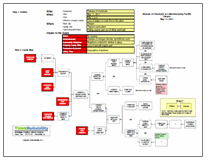A recent issue at a parts plant in Oregon caused a release of hazardous chemicals which resulted in evacuation of the workers and in-home sheltering for neighbors of the plant. Thanks to these precautions, nobody was injured. However, attempts to stop the leak lasted for more than a day. There were many contributors to the incident, which can be considered in a root cause analysis presented as a Cause Map.
To begin a Cause Map, first fill out the outline, containing basic information on the event and impacts to the goals. Filling out the impacts to the goals is important not only because it provides a basis for the Cause Map, but because goals may have been impacted that are not immediately obvious. For example, in this case a part was lost.
 Once the outline is completed, the analysis (Cause Map) can begin. Start with the impacts to the goals and ask why questions to complete the Cause Map. For example, workers were evacuated because of the release of nitrogen dioxide and hydrofluoric acid. The release occurred because the scrubber system was non-functional and a reaction was occurring that was producing nitrogen dioxide. The scrubber system had been tripped due to a loss of power at the plant, believed to have been related to switch maintenance previously performed across the street.Normally, the switch could be reset, but the switch was located in a contaminated area that could only be accessed by an electrician – and there were no electricians who were certified to use the necessary protective gear. The reaction that was producing the nitrogen oxide was caused when a titanium part was dipped into a dilute acid bath as part of the manufacturing process.
Once the outline is completed, the analysis (Cause Map) can begin. Start with the impacts to the goals and ask why questions to complete the Cause Map. For example, workers were evacuated because of the release of nitrogen dioxide and hydrofluoric acid. The release occurred because the scrubber system was non-functional and a reaction was occurring that was producing nitrogen dioxide. The scrubber system had been tripped due to a loss of power at the plant, believed to have been related to switch maintenance previously performed across the street.Normally, the switch could be reset, but the switch was located in a contaminated area that could only be accessed by an electrician – and there were no electricians who were certified to use the necessary protective gear. The reaction that was producing the nitrogen oxide was caused when a titanium part was dipped into a dilute acid bath as part of the manufacturing process.
When the responders realized they could not reset the scrubber system switch, they decided to lift the part out of the acid bath, removing the reaction that was causing the bulk of the chemicals in the release. However, the hoist switch was tripped by the same issue that tripped the scrubber system. Although the switch was accessible, when it was flipped by firefighters, it didn’t reset the hoist, leaving the part in the acid bath, until it completely dissolved.
Although we’ve captured a lot of information in this Cause Map, subsequent investigations into the incident and the response raised some more issues that could be addressed in a one page Cause Map. The detail provided on a Cause Map should be commensurate with the impacts to the goals. In this case, although there were no injuries, because of the serious impact on the company’s production goals, as well as the impact to the neighboring community, all avenues for improvement should be explored.
To view the Outline and Cause Map, please click “Download PDF” above. Or click here to read more.
